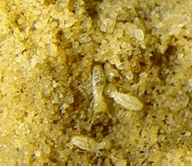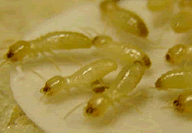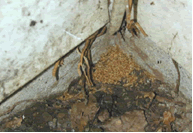 The latest Research information from Envu on "The Hazards of being too social" as it relates to Premise Termiticide. Click for the whole story and to get information on the latest Trade Offer from Envu.
The latest Research information from Envu on "The Hazards of being too social" as it relates to Premise Termiticide. Click for the whole story and to get information on the latest Trade Offer from Envu.
Premise Research Review
 Research review
Research review
The hazards of being too social:
Lethal horizontal transfer of Premise.
By Dr. Phil McNally, David Price and Karl Morris
Termites have an intricate social system where colonies delegate various tasks to different groups of castes of individuals. One caste specialises in foraging for nutrients (workers), another in producing young (reproductives), and yet another in protecting the nest (soldiers).
As separate as the functions of the different castes are, all three groups interact intimately with one another to ensure colony survival. For example, after foraging workers return to the nest, they go through trophallaxis - they regurgitate nutrients to soldiers, other workers and the developing nymphal brood in the nest, where eventually the queen consumes them.
Workers will also groom one another, removing micro-organisms and other contaminants to minimise infections or other deleterious effects. Faeces are probed and consumed. When a termite becomes impaired or dies, members of the colony will probe them and eventually remove them from the heart of the colony nest.
These behaviours benefit the colony immensely, but also represent its potential Achilles heel: What if a termiticide could be taken up by workers and then transferred throughout the colony just like nutrients? Could an application of a termiticide - directed remotely to a colony - eventually find its way to the colony and kill it? Envu researchers investigated that question using Premise Termite Elimination (active ingredient imidacloprid).

Note the blue donor termite, centre, used as part of the study
GOOD MORTALITY RATE
Subterranean termite workers were collected from the forest and placed on soil containing concentrations of Premise ranging from 100 parts per million (ppm) down to 0.1ppm. As a point of reference, label rate applications of Premise at 0.1 percent and 0.05 percent result in an equivalent soil concentration of 100ppm and 50ppm, respectively.
Five workers were left on the soil for one hour and then transferred to untreated soil containing a group of 100 termites never previously exposed to Premise. Daily observations were made to assess mortality over seven days. Donors were marked with a blue dye to differentiate them from recipients.
After seven days, 100 percent of the donors initially exposed to the 100 ppm were dead, while approximately 70 percent of the donor termites exposed to 10 ppm and even 1 ppm had died.
The recipients were also severely affected. Donors exposed to 100 ppm in the soil transferred an amount of Premise that killed 95 percent of recipients (a phenomenon the manufacturer terms the "Domino Effect."). Donors exposed to concentrations as low as 1 ppm transferred enough Premise to kill 50 percent of recipients.
Donors and recipients displayed similar symptoms of immobility and eventual death at about the same time, even though the donors were initially exposed to Premise 24 hours before the recipients. This short lag time between the appearance of symptoms in donors and recipients suggests that the toxic effects of Premise spread and become expressed throughout the termite colony quickly.

Termites feeding during the study

Termite social behaviours work to the professional's advantage when using non-repellants
BEYOND THE 'ZONE'
How far from the Premise Treated Zone can termites travel to meet unexposed termite workers and transfer lethal quantities of Premise? Our studies showed that when donors were exposed to a 0.05 percent to 0.1 percent concentration of Premise, they were free of symptoms and completely mobile for between two hours and two days.
Whatever distance an exposed termite worker can travel during this time is the distance that the worker can travel from the treated zone to transfer the lethal quantity of imidacloprid. In our field studies, we have seen aggregations of dead termites several feet from the treated zone.

Free Termite Identification Guide Available from Envu.
Click the animated image to download a pdf version of the offer from Envu. Should you wish to download a Word version, please click this link
